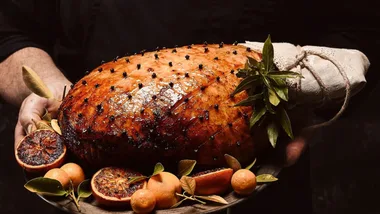Polenta has come a long way from its roots as a peasant staple – it’s now favoured by the middle classes to the astonishment, writes John Irving, of an older generation of Italians.
In a passage from her Book of Mediterranean Food, published in 1950, Elizabeth David felt obliged to explain to a war-weary Britain that, “Polenta is finely ground Indian corn meal: it makes a filling but excellent dish and this is a recipe as it is cooked by the Italian country people with large families to feed”. Such finicky specification would hardly be necessary today, for polenta’s image has changed a lot in the meantime.
In a recent edition of Just a Minute, the BBC radio program in which contestants are asked to speak about an assigned subject for a minute – without repetition, hesitation or deviation – the actress Rebecca Front had to hold forth on “revolution”. “It’s a well-known fact that revolutions begin with the middle classes,” she said. “If you want to start a revolution you simply put up the price of polenta.” Once a symbol of peasant poverty, polenta is now identified with bourgeois prosperity. A leading player in the world’s ongoing love affair with Italian regional cooking, today it’s granted star-billing on restaurant menus.
Pino Marchesin can’t fathom how or why polenta should be served in restaurants at all. Pino sells shoes at street markets in the north-western Italian region of Piedmont and, though he’s pushing 70, still works every day of the week. On Friday mornings, he plies his trade on the main piazza in Bra, the small town where I live and, after dismantling his makeshift stall, often joins me for lunch at Badellino, a hotel-restaurant near my house. Pino is a voracious eater, often finishing his dolce while I’m still at my antipasto, but there’s one thing he refuses to touch and that’s polenta. When he was a child, in the countryside near Rovigo in the Veneto, he and his family ate nothing else and now he can’t stand the sight or smell of the stuff – while maître d’ Giacomo Badellino is a polenta purist and even offers a choice between smooth and gruttulura, or grainy.
In Pino’s mind, just the word polenta conjures up memories of the bad old days of hunger and hardship, as it does for many other Italians of his generation. “Quaant se gh’a fam, la puleenta la paar salama” (“When you’re hungry, polenta seems like salami”) goes one Milanese proverb. But another popular saying, “Loda la polenta e mangia il pane” (Praise the polenta and eat the bread), evokes a more sinister side to the polenta story.
Gruels of chickpea and chestnut flour or milled cereals had been staples in Italy long before corn arrived from the New World in the 16th century. Grinding the new import and preparing it as a porridge seemed only natural. In his Opera dell’arte del cucinare, published in 1570, the Renaissance cook Bartolomeo Scappi was already writing about cooking polenta with sausage and cheese, cinnamon and saffron. But his was food for the popes, his masters. Out in the countryside, poverty-stricken Italian peasants ate polenta and little else.
The good news was that polenta helped relieve Italy of famine. The bad news was that, by the 18th century, more and more peasants were suffering from a previously unheard of degenerative disease, pellagra, the causes of which were traced to their diet, deficient in the amino acid niacin, an essential human nutrient. While the indigenous peoples of the Americas had learned the process of nixtimalisation, whereby they would boil dried corn kernels with lime or wood ash to release their niacin content (also supplementing their diet with beans and tomatoes and the like), unknowingly, and fatally, generations of Italian rural dwellers skipped this step in the polenta-making process and paid for their ignorance with pellagra.
In his travelogue Sull’oceano (On The Ocean), published in 1889, the writer Edmondo De Amicis describes masses of angry would-be emigrants from all over Italy queuing up in the port of Genoa to board a ship bound for Montevideo. Many fail their medical inspection because they are suffering from pellagra and are turned away. It’s ironic that their attempts to escape polenta for the land where polenta came from in the first place should be foiled by polenta itself.
Little wonder that, for good or for evil, polenta is ingrained in the Italian national psyche. It appears frequently in paintings, literature and cinema. In Franco Zeffirelli’s film adaptation of Shakespeare’s The Taming of the Shrew, when Petruchio (Richard Burton) tells his servants, “Go, rascals, go and fetch my supper in,” they bring a huge bowl of steaming polenta to his table. It has entered popular language in a variety of ways. “Santa polenta!” is a common exclamation of surprise where I live. Sometimes jokingly, more often than not disparagingly, northern Italians call southerners terroni (serfs). Polentoni (polenta-eaters) is the southerners’ retort, a reference to polenta’s traditional association with the north.
As always, the baiting cant of regional rivalry is based more on cliché than fact.
Though still popular in the north-eastern regions of Veneto and Friuli (now accompanied by meat and cheese and vegetables to make for a richer diet), polenta is one of many foods that cut across geographical boundaries. I tasted my first dish of it as a student in southern Tuscany. It was served with a luscious hare sauce and memory tells me it was the best I’ve ever eaten, though that might be Proust’s madeleine syndrome kicking in. Also in Tuscany, in Livorno they stir corn flour into vegetable soup to make a nourishing mush called bordatino. Another favourite of mine is polentine con bomboline – thin slices of grilled polenta with sea snails stewed in oil, garlic, marjoram, wild fennel and tomato purée – a speciality of Da Maria, a lovely little seafood restaurant in Fano, in the Marche region on the Adriatic coast. In Naples, they make the ultimate street food, scagliozzi, dainty triangles or rectangles of fried polenta, while in Basilicata, Calabria and Sicily, frascatula is a polenta reinforced with lard and potatoes or other vegetables. The list of variations on the theme could go on and on.
“No matter what conceits it may be decked with,” wrote MFK Fisher of polenta, “its fundamental simplicity survives, to comfort our souls as well as our bellies, the way a good solid fugue does, or a warm morning in spring.” Those words are all the truer today as polenta enjoys a new golden era of fresh culinary interpretations. Given its bad press in the past, who would have thought that polenta would one day become trendy? Not Pino Marchesin for a start – he’s gobsmacked.
Illustration Adriana Picker.










